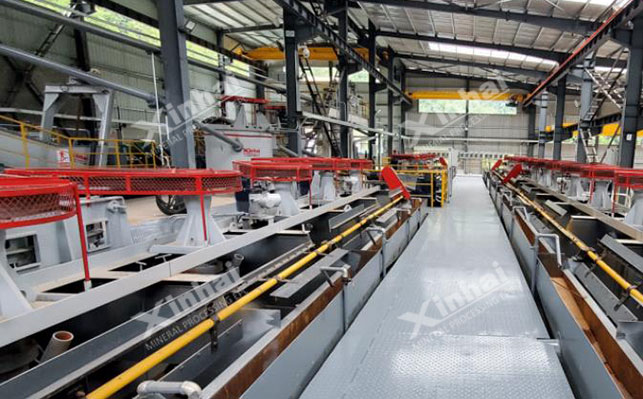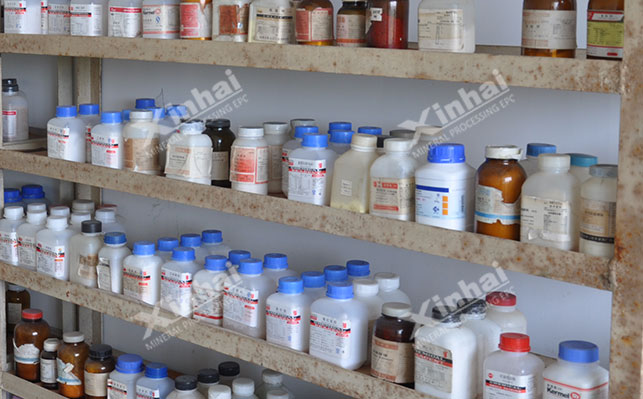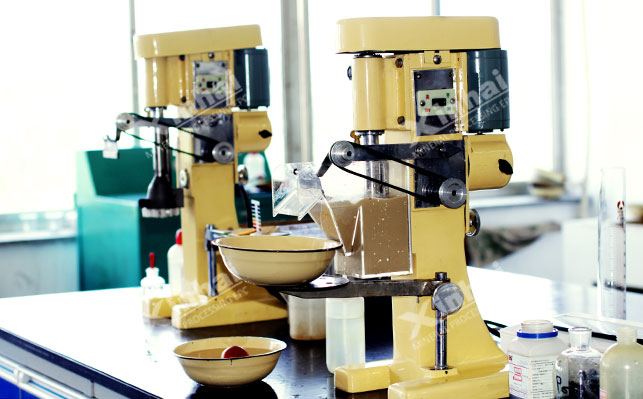
15311826613
Click to add WeChatFluorite is the main raw material for the production of hydrofluoric acid, and hydrofluoric acid is the basic raw material of organic fluorine, which plays a vital role in the chemical industry. In many fluorite ores, it is often associated with barite. When the embedded particle size is coarse, gravity separation can be used to complete the separation, but when the particle size is fine, flotation separation is required. However, in conventional flotation processes, due to the similar floatability of fluorite and barite, flotation separation is very difficult. The role of reagents in the flotation process is crucial. The commonly used flotation reagents in fluorite flotation are mainly collectors and inhibitors. If the right reagents are selected, the flotation recovery rate of fluorite and barite can reach more than 80%.

In distilled water, fluorite has a positive charge on its surface, while barite has a negative charge. Generally, fluorite is floated first in the flotation separation process, so anionic collectors are often used. Commonly used fluorite and barite flotation collectors include oleic acid, cyclohexane acid, sodium alkyl sulfate, aminoalkyl phosphoric acid, diphosphoric acid and oxidized paraffin soap, etc.

Oleic acid: is a commonly used fluorite collector in fatty acids. It has strong collection ability, small dosage, and is non-toxic, but poor selectivity, high price, and is not resistant to low temperature. The pH value of oleic acid is in the range of 7 to 10.
Nyclohexane acid: exists in alkali slag (a by-product of the petroleum industry). It has abundant raw material sources, low prices, and a low freezing point (<5℃). It has the characteristics of strong collection ability, good selectivity, and little temperature influence. It is often used as an oxide ore collector. Cycloalkane acid has a good selective collection effect on fluorite. With the assistance of a regulator, its selectivity will be greatly improved.
Sodium alkyl sulfate: Commonly used ones are sodium hexadecyl sulfate and sodium dodecyl sulfate. They are easily soluble in water, low in toxicity, good in selectivity, good in collection ability, and have certain foaming properties. They are common barite collectors.
Aminoalkylphosphoric acid: is a new type of fluorite and barite collector. Its collection ability is stronger than oleic acid, and it has good selectivity. Its collection ability for fluorite is stronger than that for barite. The flotation pH value is in the range of 3 to 7.7.
Bisphosphonic acid: is an anionic collector with strong collecting ability and resistance to low temperature; at pH value >8, its collecting ability for fluorite is greater than barite; at pH value <5, its collecting ability for barite is greater than fluorite; often used in combination with modified starch.
Oxidized paraffin soap: Made from paraffin by oxidative saponification; it has a wide range of raw materials, low price and good selectivity; it is often used in the flotation of oxidized iron ore, phosphate ore, fluorite and rare metal ore; but it is greatly affected by temperature, and the effect of using oxidized paraffin soap alone is not obvious. Oxidized paraffin soap and aminoalkylpropylene diamine can be used to prepare a mixed collector at a ratio of 10:1, which can selectively collect fluorite in the separation of fluorite and barite.
The key to the separation quality of fluorite and barite is the selection of inhibitors. Whether the inhibitor can effectively inhibit the target mineral determines the final index of the separation of fluorite and barite. Generally, barite is first inhibited to float fluorite. Commonly used fluorite and barite flotation inhibitors can be divided into three categories: polymerized carbohydrates, inorganic salts and mixed inhibitors.

Polymerized carbohydrates:Polymerized carbohydrates (including starch, dextrin, cellulose and its derivatives, etc.) have electrostatic, hydrogen bonding, hydrophobic bonding and chemical effects on the mineral surface. However, polymerized carbohydrates contain active groups such as -OH, -O- and -COOH, which can form hydrogen bond adsorption with H+ and OH- on the mineral surface. The reason why modified starch has stronger inhibitory ability than ordinary starch is mainly because its solubility increases after modification, and the main adsorption effect is still the active groups such as -OH and -O-. However, both fluorite and barite have H+ and OH- on their surfaces, so although the inhibition ability of polymerized carbohydrates is strong, the selectivity is not good enough, and they often inhibit both minerals at the same time.
Inorganic salts: Inorganic salt inhibitors have a wide source, large output, and generally low prices. Common inorganic salt inhibitors include: water glass, sodium carbonate, sulfate, sodium hexametaphosphate, and ferric chloride. Among them, sulfate inhibits barite mainly by reacting the SO42- produced by hydrolysis and ionization with the Ba2+ on the surface of barite, which inhibits the hydrophilicity of barite; water glass inhibits fluorite because anionic silica groups are produced in the aqueous solution, which preferentially adsorb on the Ca2+ on the surface of fluorite, thereby inhibiting its hydrophilicity.
Mixed depressants: Usually two or more depressants are combined. According to the different material compositions, mixed depressants can be generally divided into two types: inorganic and organic. Among them, the inorganic type is a depressant made by mixing inorganic salt compounds in a certain ratio. Commonly used inorganic salts include sodium sulfate, aluminum sulfate, water glass and sodium hexametaphosphate; organic types are often used in combination with caustic starch, dextrin and tannin.
The above are the types of flotation agents commonly used in the flotation of barite-type fluorite ore. In the actual ore dressing process, it is necessary to determine the type and amount of flotation agents based on the mineral properties of the fluorite ore, and not to blindly select agents. Therefore, it is necessary to determine the appropriate type and amount of flotation agents through ore dressing test analysis to obtain ideal fluorite concentrate.